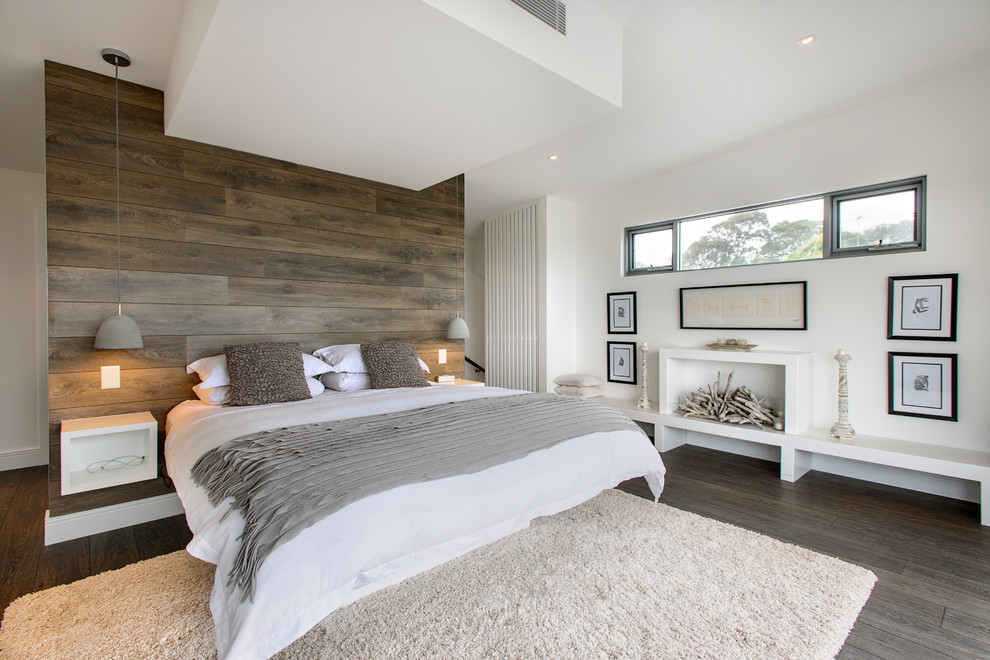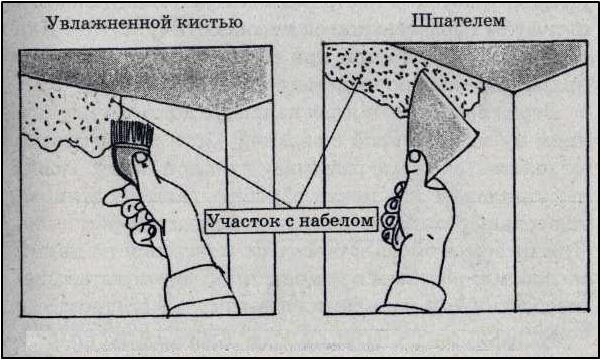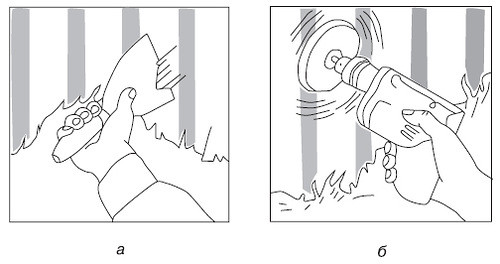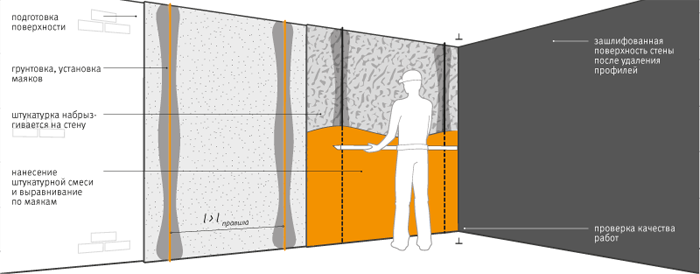It is necessary to treat the walls before wallpapering.necessarily. The service life of the wall covering directly depends on how correctly the preparatory work was carried out. The treatment of the walls before gluing the wallpaper must be of high quality, and the main stages of this work consist of cleaning the surface from old wallpaper, leveling it, priming and puttying. The puttying procedure allows you to get whitethe color of the base, which helps to avoid dark spots showing through under the wallpaper. Wallpaper should only be applied after the wall has completely dried. If you rush and start working on a damp surface, the material will quickly warp and start to fall off. This happens because the water in the glue will have nowhere to go. Wet, undried building materials will not be able to absorb it, and then the wallpaper will get wet, become heavy and start to slide off the surface. If you open doors and windows to dry wet wallpaper, the process of the glue setting to the wall and wallpaper surface is disrupted, and all materials will be hopelessly damaged. Proper preparation of the walls will ensure high-quality work and will allow you to avoid cosmetic repairs for a long time.
The puttying procedure allows you to get whitethe color of the base, which helps to avoid dark spots showing through under the wallpaper. Wallpaper should only be applied after the wall has completely dried. If you rush and start working on a damp surface, the material will quickly warp and start to fall off. This happens because the water in the glue will have nowhere to go. Wet, undried building materials will not be able to absorb it, and then the wallpaper will get wet, become heavy and start to slide off the surface. If you open doors and windows to dry wet wallpaper, the process of the glue setting to the wall and wallpaper surface is disrupted, and all materials will be hopelessly damaged. Proper preparation of the walls will ensure high-quality work and will allow you to avoid cosmetic repairs for a long time. Removing whitewash from plastered walls.Another requirement that must be met is to clean off lime, glue residue, old pieces of the base that remain after the old wallpaper has been removed. The work surface must be strong and not have a loose layer that can be scratched by metal objects. This layer will peel off under the weight of the sheets. Its presence will prevent the canvas from adhering well to the wall. The surface should not contain lime stains, dirty spots, or rust. Therefore, it is recommended to putty it before pasting. Puttying plasterboard walls before pasting protects the surface from damage. This material requires mandatory puttying in two layers. There may be fungal and mold stains on the wall. They must be neutralized, because a favorable environment for the development of microorganisms is formed under the coating layer, and the pasted wallpaper turns black after a while. To avoid such an outcome, the wall, cleaned of lime and leveled, is treated with a primer, which promotes antifungal protection. Putty is applied to the dried layer. consists of the following stages:
Removing whitewash from plastered walls.Another requirement that must be met is to clean off lime, glue residue, old pieces of the base that remain after the old wallpaper has been removed. The work surface must be strong and not have a loose layer that can be scratched by metal objects. This layer will peel off under the weight of the sheets. Its presence will prevent the canvas from adhering well to the wall. The surface should not contain lime stains, dirty spots, or rust. Therefore, it is recommended to putty it before pasting. Puttying plasterboard walls before pasting protects the surface from damage. This material requires mandatory puttying in two layers. There may be fungal and mold stains on the wall. They must be neutralized, because a favorable environment for the development of microorganisms is formed under the coating layer, and the pasted wallpaper turns black after a while. To avoid such an outcome, the wall, cleaned of lime and leveled, is treated with a primer, which promotes antifungal protection. Putty is applied to the dried layer. consists of the following stages: Tools for puttying works.
Tools for puttying works.
To work you will need:
To prepare for work, you will need to purchase the following materials:
The first stage of wall preparation
First, you need to remove excess furniture from the room andall design items that will interfere or may be damaged during construction work. All remaining items are covered with polyethylene film or thick blankets. Electrical sockets, lamps and baseboards are dismantled so as not to interfere with quality work. Electricity in the room is turned off, curtains are removed. Scheme for removing old wallpaper:a - with a spatula, b - with a drilling machine. After the approach to the work space is cleared, they begin to dismantle the wallpaper. This is a mandatory stage in the work. If they are left, the old layer may not withstand and fall off together with the new one due to the fact that the lower sheets will absorb water from the adhesive composition, get wet and float, despite the fact that everything looks perfectly glued. In order for the old wallpaper to come off well, they are moistened with warm water, using a rag or a foam roller, and after a few hours, work begins to remove them. If the wallpaper is well glued, then you can put a bucket of hot water in the room. It will steam, and the increased humidity will help the wallpaper come off the surface. They are removed with strips, and especially well-glued pieces are poured with water and removed using a notched or ordinary spatula. After the wallpaper is removed, nails and dowels in the wall are removed if they are not needed. It is also necessary to remove all cables and wires, which, according to fire safety regulations, are placed in special channels after finishing work. After all this work, the evenness of the wall is determined using a level and it is determined whether it needs to be leveled. Return to contents</a>
Scheme for removing old wallpaper:a - with a spatula, b - with a drilling machine. After the approach to the work space is cleared, they begin to dismantle the wallpaper. This is a mandatory stage in the work. If they are left, the old layer may not withstand and fall off together with the new one due to the fact that the lower sheets will absorb water from the adhesive composition, get wet and float, despite the fact that everything looks perfectly glued. In order for the old wallpaper to come off well, they are moistened with warm water, using a rag or a foam roller, and after a few hours, work begins to remove them. If the wallpaper is well glued, then you can put a bucket of hot water in the room. It will steam, and the increased humidity will help the wallpaper come off the surface. They are removed with strips, and especially well-glued pieces are poured with water and removed using a notched or ordinary spatula. After the wallpaper is removed, nails and dowels in the wall are removed if they are not needed. It is also necessary to remove all cables and wires, which, according to fire safety regulations, are placed in special channels after finishing work. After all this work, the evenness of the wall is determined using a level and it is determined whether it needs to be leveled. Return to contents</a>
Cleaning and leveling the walls
 Scheme of plastering a wall using beacons.By cleaning the walls before wallpapering with a spatula from lime residue, thick wallpaper paper, and unevenness, a hard surface is created on which the wallpaper will lie tightly. At this point, they decide whether it is necessary to plaster the surface, putty it, or whether everything is ready for work. They move on to puttying if there are rough spots or the partitions are made of plasterboard. If the surface is uneven and the differences in it are no more than 2 cm, then it requires work related to leveling, which is carried out with a gypsum plaster mixture. It allows you to apply a fairly thick layer. For proper work, beacons are applied, which help to determine the required layer of plaster. When leveling the surface, work with two spatulas and check the work with a level. They cover up traces of nails, cracks, dents and potholes that can spoil the results of the work. After the work is done, the applied layer must dry. Afterwards, it is leveled with sandpaper and antifungal primer is applied. It will increase water resistance and improve the condition of the walls. If they are even but have stains, they are not plastered, but puttied with a thin layer. After puttying, they are dried, leveled with sandpaper and the room is cleaned of white dust, which covers the entire work area. The work surface is well swept with a dry wide brush from dust. After cleaning the room, you can start gluing the wallpaper.
Scheme of plastering a wall using beacons.By cleaning the walls before wallpapering with a spatula from lime residue, thick wallpaper paper, and unevenness, a hard surface is created on which the wallpaper will lie tightly. At this point, they decide whether it is necessary to plaster the surface, putty it, or whether everything is ready for work. They move on to puttying if there are rough spots or the partitions are made of plasterboard. If the surface is uneven and the differences in it are no more than 2 cm, then it requires work related to leveling, which is carried out with a gypsum plaster mixture. It allows you to apply a fairly thick layer. For proper work, beacons are applied, which help to determine the required layer of plaster. When leveling the surface, work with two spatulas and check the work with a level. They cover up traces of nails, cracks, dents and potholes that can spoil the results of the work. After the work is done, the applied layer must dry. Afterwards, it is leveled with sandpaper and antifungal primer is applied. It will increase water resistance and improve the condition of the walls. If they are even but have stains, they are not plastered, but puttied with a thin layer. After puttying, they are dried, leveled with sandpaper and the room is cleaned of white dust, which covers the entire work area. The work surface is well swept with a dry wide brush from dust. After cleaning the room, you can start gluing the wallpaper.


